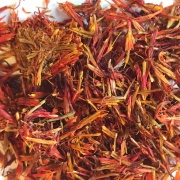Safflower (Carthamus tinctorius) LC
Description
Safflower is an annual spiny plnat uo to 1 m high. The plant is native to the are between northern India and the Near East [1].
The petals of the safflower plant (Carthamus tinctorius L.) contain several yellow dyes, but most famous is its red dye, carthamin, which has been used as a red colorant for textiles and cosmetics, especially in Asia, for centuries. Carthamin is isolated by washing safflower petals extensively with water to remove the yellow dyes, extracting the insoluble red pigment into an alkaline solution and then precipitating the red dye itself by acidification with citric or acetic acid (e.g., from lemon juice, vinegar, etc.) Often the dye is further purified by adsorption onto cotton or other substances, from which it can be re-extracted and then used for dyeing [2].
Historical Importance
Safflower was cultivated in the eastern Mediterranean since earliest antiquity and later in the South Europe (Spain, Italy and France) and the central Europe. It spread East to China along the ancient silk road around the 3rd or 4th century [1].
In the Asian tradition, safflower was usually used with a yellow dye, usually one that contains berberine, to dye a red-color [3].
Examples:
Summary of results
Sample preparation
safflower sample (~0.1g) from Tanakano, Japan was extracted with 1 mL methanol: (v:v=1:1). Then the upper 30 μl of solution was removed for HPLC-DAD-MS analysis (20 μl was injected).
HPLC-DAD
[[|600px|center|Absorbance at 350nm (mAU)]]
Result
Identified compounds
References
[1] Dominque Cardon "Natural Dyes, Sources, Tradition, Technology and Science" 54.
[2] Jan Wouters, Cecily Grzywacz, A. Claro, Markers for Identification of Faded Safflower (Carthamus tinctorius L.) Colorants by HPLC-PDA-MS, Studies in Conservation, 2010, 55, 186-203.
[3] Richard A. Laursen and Chika Mouri "Decomposition and analysis of cathamin in safflower-dyed textiles", e-Preservation Science 2013, 10, 35-37.
